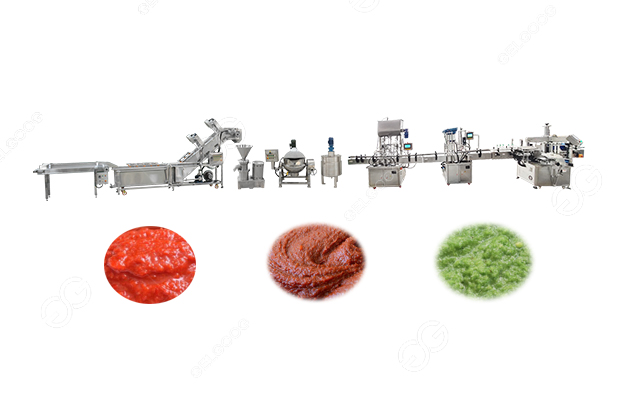Chilli sauce, a ubiquitous condiment loved by many for its fiery kick and versatile use, undergoes a meticulous manufacturing process to ensure the perfect blend of heat, flavor, and consistency. In this article, chilli sauce manufacturing process flow chart.

Cleaning:
The chilli sauce manufacturing process begins with the careful selection and cleaning of fresh chilli. At this stage, raw chilli are thoroughly inspected to remove any impurities, dirt, or foreign particles. Washing and sanitizing the chilli are crucial to maintain the quality and hygiene of the final product.
Crushing:
Once cleaned, the chilli are sent through a crushing process to break them down into smaller, more manageable pieces. This step facilitates the subsequent grinding process by preparing the chilli for optimal extraction of flavors and heat.
Sauce grinding:
The crushed chilli are then fed into a grinding machine where they are finely ground to create a chili paste. The grinding process plays a vital role in determining the texture and consistency of the chilli sauce. It’s during this stage that other ingredients, such as garlic, vinegar, and salt, are often added to the mixture to achieve the desired flavor profile.
Preparation and cooking:
The ground chilli paste, along with the added ingredients, is transferred to large cooking vessels. The mixture is carefully stirred and heated to a specific temperature to ensure the flavors meld together harmoniously. The cooking process also serves to reduce moisture content, enhance shelf life, and eliminate any potential pathogens.
Filling:
Once the chilli sauce has achieved the desired consistency and flavor, it is pumped into containers for packaging. These containers can vary in size and material, depending on the intended market and distribution channels. Precision is crucial during this step to avoid spillage and ensure accurate filling levels.
Sealing:
After filling, the containers are sealed to prevent air and contaminants from compromising the freshness and quality of the chilli sauce. Different sealing methods may be employed, including induction sealing or hot-fill and cap application. The choice of sealing method depends on factors such as product characteristics and packaging materials.
Sterilization:
The sealed chilli sauce containers undergo a sterilization process to eliminate any remaining bacteria or microorganisms. This step is vital for extending the shelf life of the product and maintaining its safety for consumption. Sterilization methods may include pasteurization, hot water bath, or steam sterilization, depending on the product and packaging.
The journey from fresh chilli to a bottled and sterilized chilli sauce involves a carefully orchestrated series of steps, each contributing to the overall quality and safety of the final product. The chilli sauce manufacturing process flow chart serves as a guide for producers, ensuring consistency and excellence in every bottle of this beloved condiment that graces dining tables worldwide. If you have any idea to start the chili sauce business, we can supply the chili sauce production line.